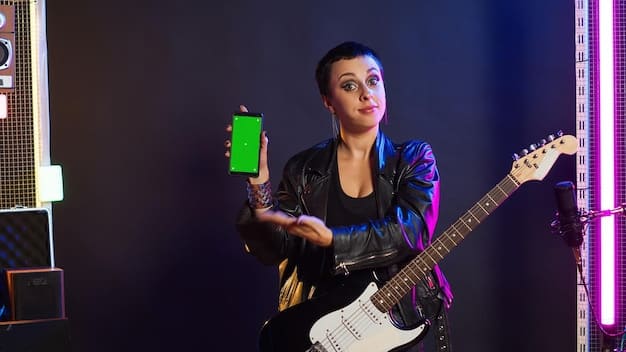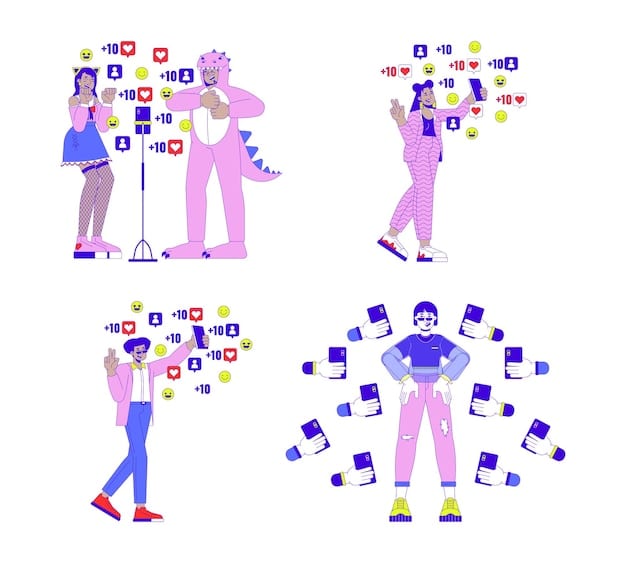Unsigned No More: TikTok’s Impact on Artist Record Deals in 2025

The landscape of music discovery and artist development has been profoundly reshaped by platforms like TikTok, creating unprecedented opportunities for independent artists to secure record deals in 2025 without traditional routes.
In the dynamic realm of music, the traditional path to securing a record deal once seemed immutable, reserved for a select few discovered through industry gatekeepers. However, as 2025 approaches, an undeniable shift has occurred, exemplified by the meteoric rise of platforms like TikTok. Here, we delve into how emerging artists are increasingly leveraging TikTok for record deals, marking a significant departure from conventional pathways and making it possible for artists to go from Unsigned No More: How Emerging Artists Are Leveraging TikTok for Record Deals in 2025.
The TikTok Phenomenon: A New A&R Landscape
TikTok has rapidly transformed into an indispensable tool for music discovery, challenging the long-established norms of the A&R (Artists and Repertoire) process within the music industry. What was once a meticulous, often opaque system of scouts attending live shows and sifting through demo tapes has evolved into a real-time, data-driven hunt for talent on a global scale. The platform’s algorithm, designed to quickly identify and amplify viral trends, has inadvertently become a powerful arbiter of musical taste and commercial viability, offering a direct conduit between artists and their potential audience, as well as industry executives.
Major record labels, traditionally reactive to market trends, have had to fundamentally re-evaluate their strategies. Instead of solely relying on their in-house A&R teams, many have established dedicated departments or partnerships focused exclusively on tracking TikTok. This strategic pivot reflects the platform’s undeniable ability to generate organic buzz and establish a verifiable fanbase before an artist even steps into a recording studio under a label contract. The data provided by TikTok – engagement rates, follower growth, sound usage, and trend participation – offers a transparent and compelling case for investment, significantly de-risking the A&R process for labels.
Real-World Success Stories Fueling the Trend
The narrative of TikTok translating into tangible success is not merely theoretical; it’s steeped in numerous high-profile examples that have reshaped public perception and industry practices. Artists who might otherwise have remained obscure have found themselves thrust into the global spotlight, often overnight, simply by sharing short, engaging musical snippets. These stories serve as powerful affirmations for aspiring musicians, demonstrating a viable, albeit unconventional, route to widespread recognition and, crucially, a record deal.
- Lil Nas X: His track “Old Town Road” exploded on TikTok, leading to a record deal and breaking multiple chart records. This was a watershed moment, proving the platform’s power.
- Doja Cat: Prior to her massive success, songs like “Say So” gained significant traction on TikTok, showcasing her unique style and helping propel her career.
- Powfu: His lo-fi track “death bed (coffee for your head)” went viral, quickly amassing millions of streams and securing a major label deal from a snippet that resonated deeply with TikTok users.
These artists didn’t follow the traditional pathway of laborious demo submissions or extensive touring to build a following. Instead, they tapped into TikTok’s vast, engaged user base, where genuine connection and authentic content are often rewarded with unparalleled exposure. Their narratives underscore a fundamental shift: talent is no longer solely discovered in back alleys or dimly lit clubs; it’s found in millions of bedrooms and studios globally, amplified by a powerful algorithm.
The success stories emerging from TikTok have not only influenced individual artist careers but have also fundamentally altered the power dynamics within the music industry. Artists now possess an unprecedented degree of leverage. They can demonstrate a pre-existing, engaged audience and a proven track record of creating marketable content before even entering negotiations. This new paradigm forces labels to offer more favorable terms, as they are no longer investing solely in potential, but in established, albeit nascent, viral phenomena. The platform has, in essence, democratized the early stages of A&R, shifting control more towards the creators themselves.
In summary, TikTok has moved beyond being just a social media app; it has become a critical, data-rich environment for talent identification. Its impact extends from inspiring countless emerging artists to completely overhauling how major labels conduct their business. This fundamental change is not a fleeting trend but a foundational shift that continues to redefine the pathway to musical stardom.
Building a Digital Presence: Beyond the Viral Clip
While the allure of a single viral clip on TikTok is undeniable, genuine, sustainable success on the platform — especially when aiming for a record deal — requires a much more comprehensive and strategic approach. It’s not merely about catching lightning in a bottle once, but about cultivating a consistent, engaging, and authentic digital identity that resonates deeply with an audience and signals long-term potential to industry scouts. Labels are looking for artists who can consistently produce engaging content and build a loyal community, not just a one-hit wonder.
An artist’s digital presence on TikTok extends far beyond just their music. It encompasses their personality, their narrative, their interaction with followers, and their ability to jump on or create new trends. Each video, whether it’s a song snippet, a behind-the-scenes recording session, a fan interaction, or a comedic sketch, contributes to a holistic brand image. This continuous output helps artists maintain relevance in TikTok’s fast-paced environment and build a genuine connection that transcends fleeting virality. The algorithm favors creators who are not only consistent but who also deeply understand their niche and their audience’s preferences.
Content Strategy for Engagement and Discovery
Developing an effective content strategy for TikTok requires a blend of creativity, analytical insight, and adaptability. It’s about understanding the platform’s nuances, the current trends, and, crucially, one’s authentic artistic voice. The goal is to create content that is not only entertaining but also highly shareable and conducive to discovery, making it easy for both new listeners and A&R representatives to find and appreciate the artistry. This often means embracing experimentation and being willing to evolve based on audience feedback and performance metrics.
- Consistency is Key: Regular posting keeps an artist relevant in the algorithm and top-of-mind for followers. A sporadic presence can lead to diminishing returns.
- Leverage Trends: Participating in trending sounds, dances, or challenges can significantly boost discoverability, provided they align with the artist’s brand.
- Showcase Personality: Audiences connect with authenticity. Sharing personal stories, creative processes, or simply showing sincere responses to comments builds loyal followers.
- Utilize Duets and Stitch: Interacting with other creators’ content can broaden reach and show artistic versatility, demonstrating an ability to collaborate and engage within the TikTok ecosystem.
- Call to Action: Encourage users to save a sound, follow the account, or check out their full songs on streaming platforms. This converts viewers into active fans and potential listeners.
Beyond these foundational tactics, a truly effective content strategy involves a deep dive into TikTok’s analytics. Understanding which types of content perform best, when the audience is most active, and how different sounds or hashtags impact reach can inform future content creation. This data-driven approach allows artists to refine their strategy, ensuring that their efforts are not just creative but also highly effective in achieving their goals. The goal is to evolve from simply posting content to strategically curating a narrative that captures the attention of both the general public and decision-makers in the music industry.
Ultimately, a robust digital presence on TikTok serves as a dynamic, living portfolio for emerging artists. It showcases not only their musical talent but also their entrepreneurial spirit, their ability to connect with an audience, and their understanding of modern digital marketing. These are qualities that record labels increasingly value, recognizing that an artist who can build and sustain a following independently is a more attractive and less risky investment. Therefore, cultivating this comprehensive digital identity beyond just going viral once is paramount for those looking to secure a record deal in 2025.
The Data-Driven Approach: What Labels Look For on TikTok
In the contemporary music industry, gut feelings and anecdotal evidence have been largely supplanted by rigorous data analysis, particularly when it comes to platforms like TikTok. Record labels, armed with sophisticated analytical tools, are no longer just looking for an artist with a good voice or a catchy melody; they are seeking quantifiable proof of market viability. TikTok provides an unparalleled wealth of data points that allow A&R teams to make informed, strategic decisions, mitigating risk and maximizing the potential for return on investment. Understanding what metrics are scrutinized is crucial for any emerging artist aiming for a deal.
The shift towards a data-driven approach means that artists on TikTok are, in essence, constantly auditioning for labels through their performance metrics. Every view, like, comment, share, and sound usage is a data point that contributes to an artist’s overall profile. Labels meticulously track these metrics to assess an artist’s current reach, growth trajectory, audience demographics, and the genuine engagement their content generates. This proactive monitoring allows them to identify emerging trends and artists before they reach peak virality, offering an early-mover advantage in a highly competitive market.
Key TikTok Metrics That Attract A&R
While a general sense of popularity is important, specific metrics hold particular weight for record labels. These metrics provide a deeper insight into an artist’s potential for sustainable success and align with the commercial objectives of a label. It’s not just about a high follower count; it’s about the quality and effectiveness of engagement, and crucially, the ability to translate TikTok success into broader market appeal.
- Sound Usage: This is perhaps the most critical metric. How many unique TikToks have been created using the artist’s original sound? High sound usage indicates virality and the potential for a track to become a breakout hit, moving beyond the artist’s immediate followers.
- Engagement Rate: This goes beyond simple likes. Labels analyze the ratio of likes, comments, and shares to views, indicating how deeply content resonates with its audience. A high engagement rate suggests a loyal and active fanbase.
- Follower Growth Trajectory: Consistent and rapid growth in followers over time, rather than a plateau, signals momentum and an increasing sphere of influence.
- Audience Demographics: Understanding who is engaging with the artist’s content allows labels to assess market fit and potential revenue streams from touring, merchandising, and brand partnerships.
- Content Versatility: Can the artist consistently produce different types of engaging content (e.g., challenges, behind-the-scenes, personal stories) that keep their audience interested beyond just single song snippets?
Beyond these quantitative metrics, labels also look for qualitative indicators of potential. This includes the authenticity of the artist’s brand, their narrative cohesion across different platforms (e.g., YouTube, Instagram, Spotify), and their responsiveness to trends while maintaining originality. They want to see an artist who is not just making noise but building a genuine connection with a community. For instance, an artist with a lower follower count but exceptionally high sound usage and direct fan interaction might be considered a more valuable investment than one with millions of followers but low engagement when they release original music.

Ultimately, a data-driven approach on TikTok enables labels to identify artists who have already demonstrated a significant level of organic market penetration and audience resonance. This minimizes the risk inherent in signing new talent and provides a clear pathway for accelerating an artist’s career through traditional label resources. For emerging artists, understanding and actively optimizing for these metrics is no longer optional; it’s a fundamental requirement for garnering serious industry attention in 2025.
Navigating the Label Landscape: What to Expect from a Deal in 2025
Securing a record deal in 2025, particularly after gaining traction on TikTok, is a significantly different proposition than it once was. The landscape has evolved, shifting power dynamics and refining the types of agreements offered. Artists emerging from platforms like TikTok often arrive at the negotiating table with leverage, having already demonstrated a proven audience and viral potential. This shifts the conversation from a traditional “development deal” to a partnership recognizing pre-existing market validation. However, it’s crucial for artists to understand the nuances of these modern contracts and what to realistically expect.
The modern record deal is more multifaceted than the conventional “360 deal” that dominated the early 2010s, though elements of it persist. Labels are increasingly focused on leveraging an artist’s established digital presence and maximizing revenue streams across various platforms and formats. This means deals might be tailored to specific rights (e.g., just master recordings, or a limited share of publishing) rather than an all-encompassing grab for every aspect of an artist’s career. Understanding the specific terms, revenue splits, and artist obligations is paramount.
Types of Deals and Key Considerations
While no two deals are identical, certain types of agreements have become more prevalent for artists emerging from the digital realm. Each comes with its own set of advantages and disadvantages, and artists must carefully weigh these against their personal career goals and the advice of their legal and management teams.
- Traditional Recording Deals: Even with TikTok fame, labels still primarily seek to own or license the master recordings of an artist’s music. These deals often involve advances, marketing budgets, and distribution infrastructure. However, the advance size and royalty splits may be more favorable to artists who have already proven their market appeal on platforms like TikTok.
- Licensing Deals: For artists with significant independence and control over their masters, a label might offer a licensing deal for a specific period or set of releases. This allows the artist to retain ownership of their intellectual property but benefit from the label’s marketing and distribution power for a set term. These are often preferred by artists with strong business acumen.
- Joint Ventures (JVs): Increasingly, labels are open to joint ventures with artists who have their own strong teams or independent labels. This involves a shared investment and shared profits, offering artists more control and a larger percentage of the revenue, reflecting their entrepreneurial contributions.
- Publishing Deals: Separate from recording, publishing deals focus on the songwriting aspect of an artist’s career. While not directly tied to TikTok virality, a song’s success on the platform significantly increases its publishing value, often leading to lucrative agreements for song placements, sync licensing, and public performance royalties.
Beyond the type of deal, several key considerations warrant meticulous attention during negotiations. The recoupment clause, detailing how advances and expenses are covered by an artist’s revenue, is always a critical point. Marketing and promotional commitments from the label, including ad spend and platform placements, are also vital. Artists should scrutinize creative control clauses, ensuring they maintain artistic integrity. Exit clauses and contract duration are essential too, allowing artists flexibility in their long-term career planning. Legal representation specializing in entertainment law is not just recommended but absolutely necessary to navigate these complex agreements.
In essence, the landscape of record deals in 2025 is more diverse and reflective of an artist’s individual leverage, particularly when that leverage is built on the undeniable metrics of TikTok success. While the dream of “selling out” remains, the reality is often a strategic collaboration where both parties aim to maximize an artist’s reach and commercial potential. Artists must be informed, strategic, and well-represented to turn TikTok virality into a truly beneficial and sustainable career.
Monetization Beyond Record Deals: Maximizing TikTok’s Potential
While a record deal remains a significant milestone for many emerging artists, the sophisticated creator understands that TikTok offers a multitude of monetization avenues that extend far beyond a traditional label contract. In 2025, artists are increasingly leveraging the platform’s ecosystem to generate revenue directly, diversifying their income streams and building a more resilient career. This approach not only provides financial independence but also strengthens an artist’s negotiating position when approaching labels, demonstrating their self-sufficiency and entrepreneurial spirit.
The digital age has empowered artists to bypass traditional gatekeepers and connect directly with their fanbase, fostering communities that are often eager to support their favorite creators financially. TikTok, with its vast reach and engagement capabilities, is an ideal platform for cultivating these direct monetization opportunities. From virtual gifts to brand partnerships, artists can transform their viral moments into tangible income, creating a robust financial foundation independent of, or in conjunction with, a record label.
Diversifying Income Streams on TikTok
A smart monetization strategy on TikTok involves exploring a variety of income sources, ensuring that an artist isn’t solely reliant on a single revenue stream. This diversification provides financial stability and allows artists to invest back into their craft, funding their own music production, marketing, and creative endeavors.
- TikTok Creator Fund: While not a primary income source, this fund provides a baseline revenue for popular creators based on views and engagement. It’s a starting point for direct platform earnings and indicates overall content performance.
- Live Streams and Virtual Gifts: TikTok Live allows fans to send virtual gifts (purchased with real money) to creators during live broadcasts. This is a direct and immediate way to earn money and engage with a loyal fanbase in real-time, often during Q&A sessions or impromptu performances.
- Brand Partnerships and Sponsored Content: Artists with significant reach and engagement are highly attractive to brands looking to promote products or services. This can involve creating sponsored videos, integrating products naturally into content, or participating in brand campaigns. These deals often offer substantial compensation and are lucrative outside of music royalties.
- Merchandise Sales: TikTok can serve as a powerful marketing channel for artist merchandise. Linking to an external store from their profile allows artists to sell branded apparel, accessories, or physical music, leveraging their online popularity into direct sales.
- Driving Traffic to Streaming Platforms: While not direct TikTok monetization, the platform’s primary value for musicians is its ability to drive traffic to their full songs on Spotify, Apple Music, and other streaming services, where they earn publishing and master recording royalties. Effective calls to action on TikTok can significantly boost these streams.

Furthermore, artists can use TikTok to promote their Patreon, Kickstarter campaigns, or direct fan subscription services, offering exclusive content or early access in exchange for direct financial support. This micro-patronage model is particularly powerful for fostering a dedicated community willing to invest in an artist’s journey. The key is to be transparent with the audience about these initiatives and provide genuine value in return for their support.
By actively pursuing these diverse monetization strategies, emerging artists transform TikTok from merely a discovery platform into a powerful and multifaceted business tool. This empowers them not only to sustain their creative endeavors but also to approach record labels from a position of strength, showcasing a proven ability to generate revenue and manage a growing enterprise. For artists in 2025, financial acumen and diversification are equally as important as musical talent on the path to becoming Unsigned No More.
The Future of Artist Development: Beyond the Major Label
As we look towards the future of artist development in 2025 and beyond, it’s increasingly clear that the traditional major label model is no longer the sole, or even primary, pathway to sustainable success. While major labels continue to offer significant resources, including marketing, distribution, and funding, the rise of powerful independent tools and platforms like TikTok has empowered artists to carve out their own careers with unprecedented autonomy. This is leading to a more diversified and artist-centric industry, where success isn’t defined solely by the breadth of a label’s reach but by the depth of an artist’s connection with their audience.
The democratization of music production, distribution, and promotion means that artists can now achieve levels of exposure and revenue that were once reserved for signed acts. Digital distributors can place music on every major streaming service globally within days. Social media provides direct access to billions of potential fans. Collaborative tools enable remote songwriting and production. This ecosystem fosters an environment where artists can build legitimate, profitable careers without traditional institutional backing, forcing major labels to adapt their value proposition.
The Rise of Independent Powerhouses and Hybrid Models
The trajectory points towards a future dominated by hybrid models and the emergence of independent powerhouses. Artists are increasingly forming their own teams, acting as their own mini-labels, and partnering with services that provide specific, unbundled support rather than signing away broad swaths of their careers. This approach prioritizes control, higher revenue splits, and creative freedom, appealing to a new generation of artist-entrepreneurs.
- Artist-Owned Labels: More artists are choosing to release music through their own imprints, retaining full ownership of their masters and publishing. They then outsource services like distribution, PR, and radio promotion on a project-by-project basis.
- DIY Marketing Prowess: Leveraging platforms like TikTok, artists are becoming adept at self-promotion and audience engagement, often outperforming traditional label marketing efforts in terms of authenticity and direct fan connection.
- Strategic Partnerships: Instead of signing traditional deals, artists are opting for strategic partnerships with distribution companies, independent pluggers, or even venture capital firms interested in their intellectual property. These deals are often more favorable, allowing artists to maintain significant equity.
- Web3 and Blockchain Influence: While still nascent, Web3 technologies (NFTs, decentralized streaming platforms) promise to further empower artists by enabling direct fan-to-artist engagement, novel monetization models, and transparent royalty distribution, potentially cutting out many traditional intermediaries.
The implications of this shift are profound for both artists and the industry. For artists, it means greater control over their creative vision, their brand, and their financial destiny. They can build careers on their own terms, fostering deeper connections with fans who appreciate their independence. For major labels, it necessitates a recalibration of their role. They are evolving from controlling entities to service providers, offering capital, global infrastructure, and specialized expertise that independent artists might still need to scale their operations to the highest level.
Thus, the future of artist development isn’t about the major label disappearing, but rather about its transformation into one of many powerful options available to artists. The most thriving artists in 2025 will be those who strategically combine their digital savviness and independent entrepreneurial spirit with targeted, beneficial partnerships, whether that’s with a major label, an independent distributor, or direct-to-fan platforms. This adaptive model emphasizes autonomy and smart collaboration, ensuring artists can effectively navigate a rapidly changing music ecosystem.
Cultivating Authenticity: The Key to Long-Term TikTok Success
In the crowded and often ephemeral world of social media, particularly on a platform as trends-driven as TikTok, standing out consistently requires more than just catchy music or viral challenges. The artists who achieve not only fleeting fame but also long-term, sustainable careers on TikTok are those who master the art of authenticity. Cultivating a genuine and relatable personal brand is paramount, as an engaged audience is far more likely to support an artist’s journey beyond a single viral sound. This authenticity resonates deeply with users, fostering a loyal community that transcends passing fads.
Authenticity on TikTok means being true to oneself, sharing vulnerabilities, and allowing the audience a glimpse into the unfiltered creative process. It involves a willingness to experiment, to fail publicly, and to openly engage with critiques and praise. This transparency builds trust and connection, making the audience feel invested in the artist not just as a musician, but as a person. In an age of curated perfection, raw, honest content often cuts through the noise more effectively, attracting genuine fans who appreciate integrity and grit.
Strategies for Building a Genuine Online Persona
Building an authentic online persona is an ongoing process that requires self-awareness, consistency, and a deep understanding of one’s own artistic and personal narrative. It’s about finding the sweet spot between showcasing talent and revealing enough of one’s personality to forge a meaningful connection with viewers. This strategic approach ensures that the “brand” is organic, not manufactured, and can withstand the test of time and changing trends.
- Share Your Story: Beyond just music, tell your journey, challenges, and inspirations. People connect with narratives and vulnerability. This can be through “storytime” videos, Q&As, or mini-documentaries about your creative process.
- Engage Genuinely: Respond to comments, duet with fan creations, and acknowledge your supporters. This reciprocal interaction shows appreciation and makes followers feel seen and valued.
- Be Consistent in Tone: While content types can vary, maintain a consistent voice and personality across all your TikToks. This helps build a recognizable and reliable brand image.
- Embrace Imperfection: Don’t strive for polished perfection that feels manufactured. Raw, unedited moments often connect more deeply. Showing behind-the-scenes struggles or bloopers can humanize an artist.
- Showcase Your Creative Process: From songwriting snippets to studio time, sharing glimpses of how music comes to life provides an intimate connection. This allows fans to appreciate the effort and artistry involved.
Moreover, authenticity also extends to how artists manage their online interactions and partnerships. When collaborating with brands, it’s crucial that the products or services genuinely align with the artist’s values and aesthetic, otherwise, the endorsement can feel disingenuous. Similarly, when engaging with other artists or industry figures, maintaining a respectful and collaborative spirit reinforces a positive, authentic image.
Ultimately, long-term success on TikTok, particularly for artists hoping to make the leap to a record deal, hinges on the ability to translate fleeting attention into enduring loyalty. Authenticity is the bedrock of this transition. It’s what transforms passive viewers into active fans, and what convinces labels that an artist isn’t just a flash in the pan but a credible, relatable talent with a dedicated following ready to support them long after the initial viral hit. In 2025, genuine connection is the ultimate social currency.
Legal and Managerial Advice: Protecting Your Rights on the Journey to a Deal
For emerging artists leveraging TikTok for record deals in 2025, the journey from viral sensation to signed talent is fraught with legal and managerial complexities. While the platform offers unprecedented access to industry scouts, it also necessitates a proactive approach to protecting one’s intellectual property and ensuring equitable agreements. Without proper guidance, artists can inadvertently jeopardize their future earnings, creative control, and long-term career viability. Therefore, securing competent legal and managerial representation is not a luxury, but a fundamental necessity.
The speed at which TikTok success can materialize often means artists are thrust into negotiations with major players without adequate preparation. Labels and publishers operate with sophisticated legal teams, and artists, especially those new to the business, can find themselves at a severe disadvantage. Understanding contractual nuances, intellectual property rights, and potential pitfalls is crucial to avoid costly mistakes that could impact an entire career. This proactive protection ensures that an artist benefits fully from their hard-earned virality.
Essential Protections and Professional Guidance
Navigating the complex ecosystem of record deals, publishing agreements, and brand partnerships requires a team of trusted professionals. These advisors act as crucial intermediaries, advocating for the artist’s best interests, deciphering legal jargon, and ensuring that all agreements are fair and sustainable. Their expertise is invaluable in transforming short-term TikTok fame into a structured, profitable, and long-lasting career.
- Entertainment Lawyer: This is arguably the most critical professional an artist needs. An entertainment lawyer reviews all contracts (record deals, publishing deals, licensing agreements, brand partnerships) to ensure favorable terms, protect intellectual property, and prevent an artist from signing away rights they don’t fully understand. They negotiate on the artist’s behalf and explain complex legal clauses.
- Artist Manager: A good manager acts as the CEO of an artist’s career, overseeing strategy, building industry relationships, managing schedules, and coordinating the broader team (lawyers, publicists, agents). They identify opportunities, guide career development, and help shape the artist’s brand and long-term vision.
- Business Manager/Accountant: As income streams diversify (royalties, advances, brand deals, merchandise), a business manager or accountant becomes essential for handling finances, tracking revenue and expenses, managing taxes, and ensuring financial health. They provide transparency and strategic financial planning.
- Copyright Registration: Before a song goes viral or is offered to a label, artists should register their copyrights with the appropriate national office (e.g., U.S. Copyright Office). This provides legal proof of ownership and strengthens an artist’s position in any future disputes or contractual negotiations.
- Trademark Your Artist Name: Protecting your artist name, band name, or logo through trademark registration prevents others from using it commercially, safeguarding your brand identity and preventing potential legal battles in the future.
Moreover, artists considering a record deal should be wary of clauses that might restrict their creative control, limit their ability to release music independently in the future, or commit them to unfavorable revenue splits for ancillary income (e.g., merchandise, touring). Confidentiality agreements and non-disclosure agreements (NDAs) are common in early discussions but should also be reviewed by legal counsel. Understanding the duration of contracts, renewal options, and conditions for termination is equally vital.
In essence, while TikTok provides the stage, professional legal and managerial guidance provides the crucial safeguards. For emerging artists aiming to go from being Unsigned No More in 2025, building a strong support team around them is as important as creating compelling music. This strategic foresight ensures that their hard-earned success is not only celebrated but also protected and maximized for a prosperous and sustained career.
| Key Point | Brief Description |
|---|---|
| 📊 TikTok A&R Shift | Labels now prioritize TikTok data (sound usage, engagement) for artist discovery, replacing traditional scouting. |
| 📈 Beyond Virality | Consistent content, authentic personality, and audience engagement are crucial for long-term success, not just one viral moment. |
| 💰 Diverse Monetization | Artists can earn from TikTok’s Creator Fund, live streams, brand deals, and driving traffic to streaming services, boosting independence. |
| ⚖️ Protect Your Rights | Legal and managerial advice is vital for navigating contracts, securing IP, and ensuring fair terms in record deals. |
Frequently Asked Questions
▼
Consistent content creation is paramount. While a single viral video can draw initial attention, record labels look for artists who can maintain engagement and demonstrate a sustainable connection with their audience over time. Regular posting signals dedication, versatility, and the ability to build and retain a loyal fanbase, all crucial factors for a long-term investment.
▼
Labels heavily prioritize “sound usage” (how many users create videos using an artist’s original sound) as a key indicator of virality. Additionally, they examine engagement rates (likes, comments, shares relative to views), follower growth trajectory, and audience demographics. These metrics provide concrete data on market potential and audience resonance, which de-risk investments.
▼
Absolutely. TikTok has democratized the discovery process, allowing artists to bypass traditional gatekeepers. Many successful artists signed deals based solely on their organic TikTok virality, proving that strong digital presence and audience engagement can serve as the primary “connection.” However, building genuine relationships within the industry once attention is gained is still beneficial.
▼
Artists might encounter various deals, including traditional recording contracts (often with more favorable terms due to pre-existing leverage), licensing deals (allowing the artist to retain master ownership), or even joint ventures. Publishing deals are also common for songwriting. The specific terms will largely depend on the artist’s existing leverage and the label’s strategic objectives.
▼
A strong legal and managerial team is vitally important. The music industry’s contracts are complex, and without expert guidance, artists risk signing away rights or agreeing to unfavorable terms. Lawyers protect intellectual property and negotiate deals, while managers strategically guide career development. These professionals ensure an artist’s long-term success and financial well-being post-TikTok fame.
Conclusion
The journey from an unsigned artist to a signed talent in 2025 has been irrevocably reshaped by TikTok, catapulting countless musicians into the spotlight and onto record labels’ radars. This transformation underscores a new era in artist discovery, one where organic virality and authentic audience engagement often outweigh traditional industry pipelines. For emerging artists, TikTok is not merely a platform for sharing music; it is a dynamic, data-rich environment that, when strategically cultivated, can directly lead to life-changing record deals. However, success on this path demands more than just a viral clip; it requires consistent content creation, a deep understanding of data metrics, a proactive approach to intellectual property, and a robust support team. As the music industry continues to evolve, the artists who leverage TikTok’s full potential—building genuine connections, diversifying income streams, and navigating legal complexities—will truly become Unsigned No More, defining the future of musical stardom on their own terms.





